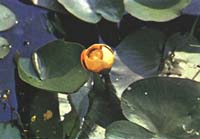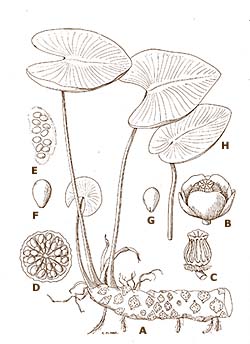
 |
Gathering
Yellow pond lily |
There are also many roots which the women gather. The one which they like best is the macopine. (Pierre Delliette, 1702)![]()
In addition to the crops they grew in their fields, Illinois women also gathered many wild plant foods. In spring they tapped maple trees to make sugar and syrup. Fruits were gathered in season, including plums, apples, grapes, persimmons, mulberries, and blackberries. In the fall, they harvested nuts from hazelnut bushes and from pecan, walnut, and hickory trees.
According Father Claude Allouez, who visited in 1677, the Illinois also gathered 14 different kinds of roots in the prairies--"they made me eat some and I found them good and very sweet." Their favorite was a large root, gathered in marshes, which they called macopine (probably the yellow pond lily or common spatterdock, Nuphar advena). These roots were cooked by baking them in large fire pits over a pavement of red-hot stones, all of which was covered over with layers of grass, bark, and earth.![]()
A. Plant with thick rootstock
![]()
Drawing of yellow pond lily (Nuphar advena) showing large rootstock. (Muenscher 1944)
B. Flower
C. Fruit
D. Cross section of fruit
E. A baglike section from a fruit containing several seeds
F. Seed
G. Seed
H. Leaf
|
|
Copyright © 2000 Illinois State Museum
